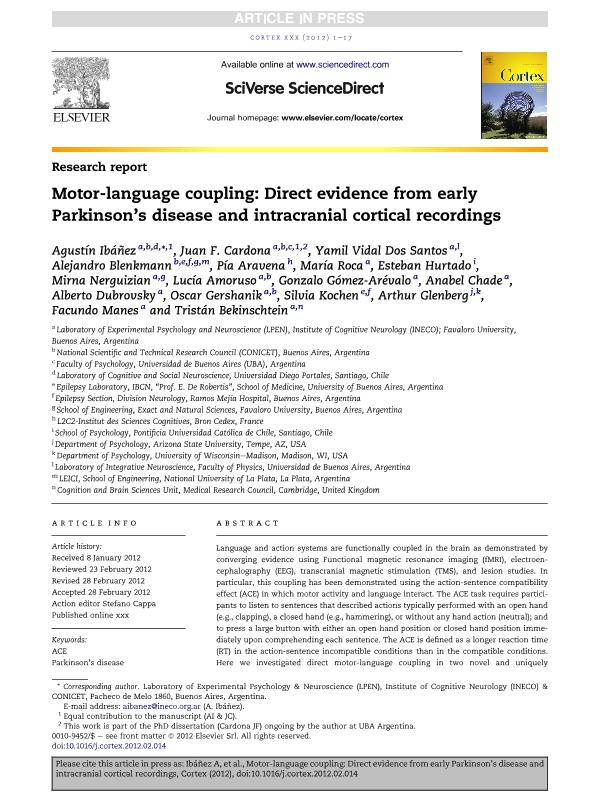Artículo
Motor-language coupling: Direct evidence from early Parkinson's disease and intracranial cortical recordings
Ibañez, Agustin Mariano ; Cardona, Juan F.; Dos Santos, Yamil Vidal; Blenkmann, Alejandro Omar
; Cardona, Juan F.; Dos Santos, Yamil Vidal; Blenkmann, Alejandro Omar ; Aravena, Pía; Roca, María
; Aravena, Pía; Roca, María ; Hurtado, Esteban; Nerguizian, Mirna; Amoruso, Lucía
; Hurtado, Esteban; Nerguizian, Mirna; Amoruso, Lucía ; Gómez Arévalo, Gonzalo; Chade, Anable; Dubrovsky, Alberto; Gershanik, Oscar; Kochen, Sara Silvia
; Gómez Arévalo, Gonzalo; Chade, Anable; Dubrovsky, Alberto; Gershanik, Oscar; Kochen, Sara Silvia ; Glenberg, Arthur; Manes, Facundo Francisco
; Glenberg, Arthur; Manes, Facundo Francisco ; Bekinschtein, Tristán Andrés
; Bekinschtein, Tristán Andrés
 ; Cardona, Juan F.; Dos Santos, Yamil Vidal; Blenkmann, Alejandro Omar
; Cardona, Juan F.; Dos Santos, Yamil Vidal; Blenkmann, Alejandro Omar ; Aravena, Pía; Roca, María
; Aravena, Pía; Roca, María ; Hurtado, Esteban; Nerguizian, Mirna; Amoruso, Lucía
; Hurtado, Esteban; Nerguizian, Mirna; Amoruso, Lucía ; Gómez Arévalo, Gonzalo; Chade, Anable; Dubrovsky, Alberto; Gershanik, Oscar; Kochen, Sara Silvia
; Gómez Arévalo, Gonzalo; Chade, Anable; Dubrovsky, Alberto; Gershanik, Oscar; Kochen, Sara Silvia ; Glenberg, Arthur; Manes, Facundo Francisco
; Glenberg, Arthur; Manes, Facundo Francisco ; Bekinschtein, Tristán Andrés
; Bekinschtein, Tristán Andrés
Fecha de publicación:
04/2013
Editorial:
Elsevier Masson
Revista:
Cortex
ISSN:
0010-9452
Idioma:
Inglés
Tipo de recurso:
Artículo publicado
Clasificación temática:
Resumen
Language and action systems are functionally coupled in the brain as demonstrated by converging evidence using Functional magnetic resonance imaging (fMRI), electroencephalography (EEG), transcranial magnetic stimulation (TMS), and lesion studies. In particular, this coupling has been demonstrated using the action-sentence compatibility effect (ACE) in which motor activity and language interact. The ACE task requires participants to listen to sentences that described actions typically performed with an open hand (e.g., clapping), a closed hand (e.g., hammering), or without any hand action (neutral); and to press a large button with either an open hand position or closed hand position immediately upon comprehending each sentence. The ACE is defined as a longer reaction time (RT) in the action-sentence incompatible conditions than in the compatible conditions. Here we investigated direct motor-language coupling in two novel and uniquely informative ways. First, we measured the behavioural ACE in patients with motor impairment (early Parkinson’s disease – EPD), and second, in epileptic patients with direct electrocorticography (ECoG) recordings. In experiment 1, EPD participants with preserved general cognitive repertoire, showed a much diminished ACE relative to non-EPD volunteers. Moreover, a correlation between ACE performance and action-verb processing (kissing and dancing test – KDT) was observed. Direct cortical recordings (ECoG) in motor and language areas (experiment 2) demonstrated simultaneous bidirectional effects: motor preparation affected language processing (N400 at left inferior frontal gyrus and middle/superior temporal gyrus), and language processing affected activity in movement-related areas (motor potential at premotor and M1). Our findings show that the ACE paradigm requires ongoing integration of preserved motor and language coupling (abolished in EPD) and engages motor-temporal cortices in a bidirectional way. In addition, both experiments suggest the presence of a motor-language network which is not restricted to somatotopically defined brain areas. These results open new pathways in the fields of motor diseases, theoretical approaches to language understanding, and models of action-perception coupling.
Palabras clave:
Ace
,
Parkinson'S Disease
,
Ecog
,
Intracranial N400
,
Intracranial Mp
Archivos asociados
Licencia
Identificadores
Colecciones
Articulos(IRICE)
Articulos de INST.ROSARIO DE INVEST.EN CS.DE LA EDUC. (I)
Articulos de INST.ROSARIO DE INVEST.EN CS.DE LA EDUC. (I)
Articulos(SEDE CENTRAL)
Articulos de SEDE CENTRAL
Articulos de SEDE CENTRAL
Citación
Ibanez Barassi, Agustin Mariano; Cardona, Juan F.; Dos Santos, Yamil Vidal; Blenkmann, Alejandro Omar; Aravena, Pía; et al.; Motor-language coupling: Direct evidence from early Parkinson's disease and intracranial cortical recordings; Elsevier Masson; Cortex; 49; 4; 4-2013; 968-984
Compartir
Altmétricas



